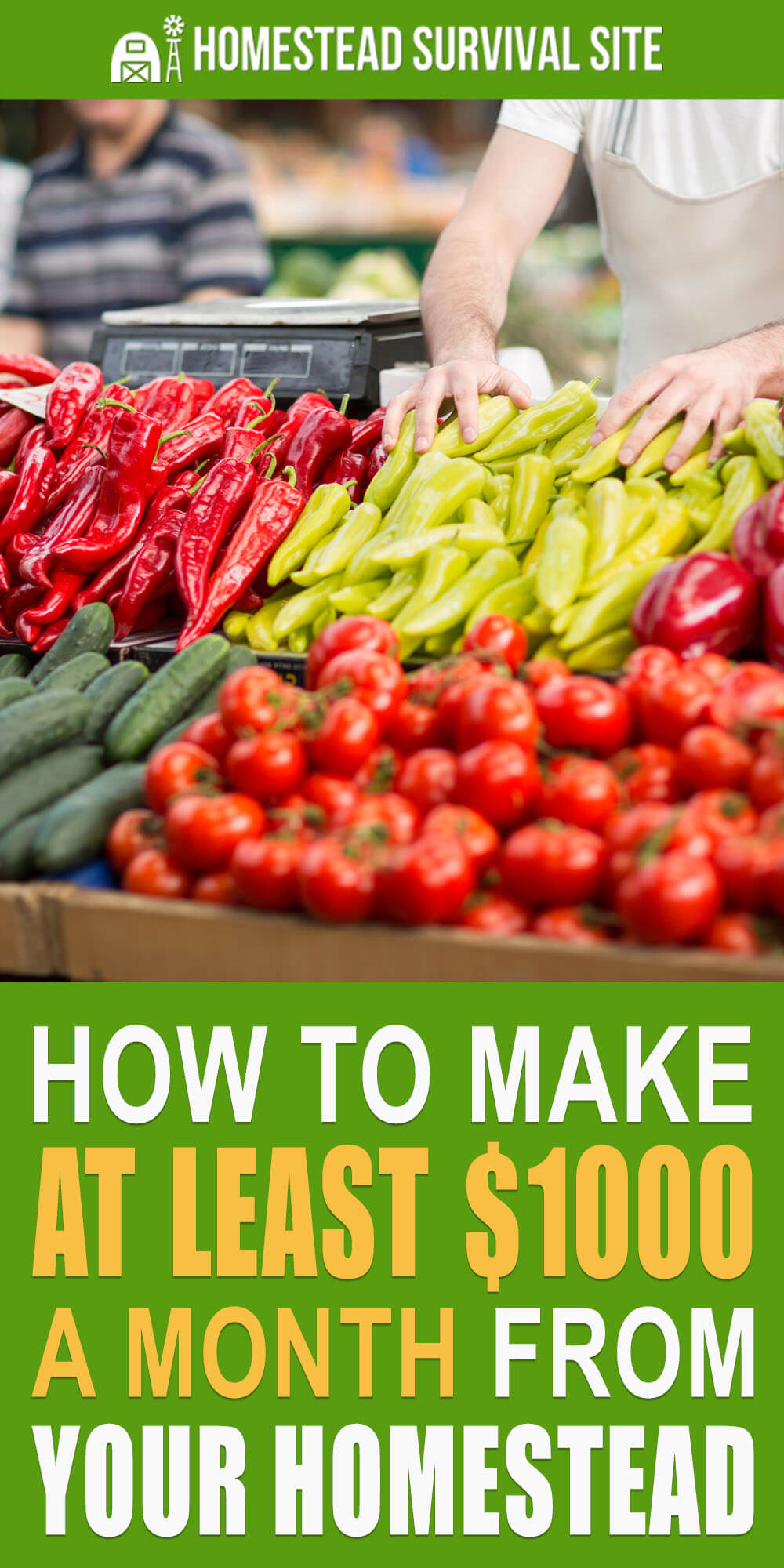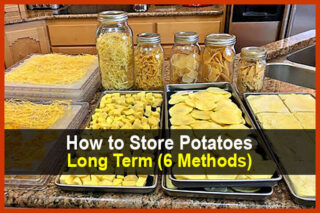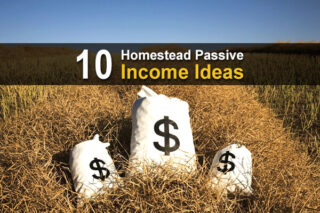Estimated reading time: 8 minutes
Making money with a homestead is not a difficult task, but it sure can be time-consuming. If you plan to make a living off of your homestead, it will require a time investment equal to a 40-hour per week job.
Instead of quitting your job to live off the land immediately, make a more fiscally sound decision and begin by merely supplementing existing income and earning a bit of extra money from the homesteading life.
Want to save this post for later? Click Here to Pin It on Pinterest!
There are many ways to make money homesteading, no matter how many acres you have. While rural homesteaders on spacious tracts of land have a greater abundance of natural resources, crop cultivation, and livestock raising space than suburban homesteaders, “townies” could potentially earn a full-time income if living on a half-acre to one-acre homestead.
Because the majority of homesteads in the United States are comprised of five acres or less, this homesteading money making guide will focus on small tract side hustles.
Top 3 Ways To Make Money With A Homestead
If you do all of these things, you ought to be able to earn at least $1000 a month with your homestead. Now obviously, we can’t make any promises. Sometimes people have bad luck, and oftentimes business starts slow and grows over time. But with hard work and patience, there’s no reason you shouldn’t be able to make a nice supplemental income.
Chicks, Ducklings, And Keets
Instead of eating or selling all of the eggs produced on your homestead, incubate some batches of baby poultry birds instead. Even if your homestead is a small one, the space required to set up an incubator is minimal.
Straight run (not sexed) chicks and ducklings of common breeds regularly sell for $3 to $5 each during the spring and all. Guinea keets often demand a higher price tag of $5 to $7 because fewer breeders exist and the little ones tend to be more fragile than other young poultry birds.
If you focus your egg hatching operations on rare or heritage breeds, the price per bird should increase significantly. It is possible to garner up to $10 per hatchling when quality young birds are produced – or if your hatchlings are sexed, allowing you to sell them as pullets or cockerels.
By joining groups like The Livestock Conservancy (about $4 per year for a basic membership), you can have your homestead noted in their breeder's list and sale and ship your birds on a national scale. Becoming involved in local, statewide, or online groups for both breeders and keepers, the potential sales base also expands exponentially.
Incubators, like this one, which is capable of hatching up to 40 chicken, duck, or guinea eggs at once range in price from $100 to $150, on average. Make sure to purchase an incubator that comes with an automatic egg turner. If you opt for a lower end model, you will have to manually turn each egg at least three times per day.
You can purchase a brooder for your hatchlings for about the same price as the incubator, but it is far cheaper to make the simple temporary housing structure yourself. A brooder simply need enough safe space for the hatchlings to move about freely, clean bedding, a feeder, waterer, and heat lamps.
The sides of the brooder must be tall enough so the little birds cannot fly out. That or it should at least have some type of a top (a piece of hardware cloth will work fine) to keep them in. Some folks use plastic baby pools as an incubator, but using any type of a plastic housing unit poses a fire risk due to the intense heat put off by the lamps.
A simple rabbit hutch style cage or metal livestock tub are both safer options than a plastic container. You can use a brooder indoors or out, depending on the time of year the chicks are born and the climate where you live.
Here's how to build a chick brooder in 30 minutes for $30:
Selling eggs is a traditional homesteading endeavor and can provide a small amount of steady income from your land, but selling live birds will generally create more profitable income.
Wool
The wool sheared from the sheep on your homestead can fetch top dollar from fiber artists and handicrafters who love to make homemade toys. Even if there is not much of a market for wool where you live – or you simply don't know how to connect with potential customers – selling wool online on sites like Etsy can be a highly lucrative proposition.
Cleaned raw wool can garner as much as $25 per pound. If you learn how to naturally dye the wool (a fun and simple project for the entire family) the possibilities for both increased sales and revenue abound. Typically, just a few ounces of naturally dyed sheep, alpaca, or goat fleece sells for between $5 to $7 a bag.
Are you crafty? If you or someone in your household would love to spend an afternoon crafting (or is willing to learn), the wool from your homestead can be put to an even more enviable money making use.
Dyed wool can be used in wet felting projects to create 3D decor, wall hangings, one-of-a-kind sheets of felt, animals, dolls, and so much more. Wet felting is a simple process that does not require expensive tools or supplies.
Here's a video that explains the basics:
You could even create your own wet felting patterns and make kits to sell to artisans and scouting groups.
Needle felted animals, like this one, are often sold for $25 to $100 each.
Needle felted and/or wet felted playscapes (i.e. play mats) garner an even higher price. As an example, here's a stone bridge over a river.
The combination of wet felting and needle felting can also be used to create scarves and hats. The cost to get started in this type of fiber art? About $8. A large set of felting needles sells for less than that on Amazon.
The only other supplies you need to wet felt are: soap, warm water, a bowel or spray bottle, plastic or bubble wrap, and a towel.
Backyard Greenhouse
Growing and saving extra seeds to sell from a stand on your own property, at a local farmers market, and online can provide a steady stream of income nearly year around. Although spring is the time that most greenhouses are the busiest, you could also cultivate fall crop plants and dwarf fruit trees in your backyard greenhouse.
The space you have available will dictate how large a greenhouse or extra growing operation you can operate. If you live in a “Right To Farm” state, odds are you can open the greenhouse to the public or sell from a stand in your own front yard without insurance or permit hassles.
Growing herbs and roots, especially medicinal ones, can also help expand your homestead greenhouse business into a more year-round status.
Selling heirloom or non-GMO seeds will set you apart from many if not most of the commercial greenhouses and agriculture stores in the area.
In addition to selling various seeds and plants, consider making garden decor and portable growing containers to sell as part of the homesteading side hustle. You could use simple little packets decorated with your unique touch to sell seeds both locally and online.
Share your gardening knowledge by creating your own guide books in both print and ebook form. Creating and printing your own books is incredibly simple and inexpensive. Thanks to websites like CreateSpace. As long as you design and upload your own book cover, there is no charge for writing a book through that website and similar ones. The only cost involved is in the printing, which is surprisingly nominal. There is a bit of a price jump for including color photos, though.
Homesteading Business Hints And Tips
Do what you love. Turning a profit will be a less tedious and obstacle-filled task if you are sharing a passion via skills you've already honed. Even if selling wool sounds like a fabulous way to make extra money with a homestead, if you have little to no experience raising and shearing sheep, you could be setting yourself up for an epic failure.
Start small and expand your homesteading side hustle only once you have at least 12 months under your belt. Over-investing time or money (or both) into a new venture could cause what might be a profitable and long-standing source of income into a jumbled and overwhelming nightmare.
Keep accurate records – the government is watching. You must document all income earned through the homesteading business for income tax purposes. On the upside, using your homestead as not merely a hobby but a business opens the door for a myriad of tax deductions.
If you are raising sheep for wool, the cost of the feed, water, housing, etc, used to keep the animals should be tax deductible. Typically, a portion of utility costs on a working farm can be deducted from income taxes as long as the water, electricity, or another utility was used in your husbandry efforts.
Get into the habit of writing down the mileage on every receipt when a visit to the store, event, or training class is related to the homesteading business. You should also be able to take a home office deduction off of your income taxes if a room or portion of a room inside the home was used for typical business or office activity.
Like this post? Don't forget to Pin It on Pinterest!










lov lov lov this im trying to homestead you are so helpfull thank youuuuuuu cj